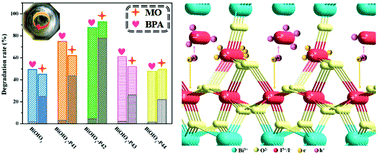当前位置:
X-MOL 学术
›
Green Chem.
›
论文详情
Our official English website, www.x-mol.net, welcomes your
feedback! (Note: you will need to create a separate account there.)
A solvent-free strategy to realize the substitution of I− for IO3− in a BiOIO3 photocatalyst with an opposite charge transfer path
Green Chemistry ( IF 9.3 ) Pub Date : 2020/01/24 , DOI: 10.1039/c9gc03731d Jing Xie 1, 2, 3, 4, 5 , Yali Cao 1, 2, 3, 4, 5 , Jindou Hu 1, 2, 3, 4, 5 , Yakun Tang 1, 2, 3, 4, 5 , Dianzeng Jia 1, 2, 3, 4, 5
Green Chemistry ( IF 9.3 ) Pub Date : 2020/01/24 , DOI: 10.1039/c9gc03731d Jing Xie 1, 2, 3, 4, 5 , Yali Cao 1, 2, 3, 4, 5 , Jindou Hu 1, 2, 3, 4, 5 , Yakun Tang 1, 2, 3, 4, 5 , Dianzeng Jia 1, 2, 3, 4, 5
Affiliation

|
Substitutional doping is an effective way to improve photocatalytic activity, but substituting an individual ion for an atomic group has always been difficult to achieve. Herein, a simple in situ solvent-free strategy is reported for the synthesis of a photocatalyst by replacing IO3− in BiOIO3 with I− (BiOIO3-P42) via regulating the oxidation–reduction environment, which has been realized by changing the viscosity of the reaction system. Exhilaratingly, the change in the viscosity of the reaction system facilitated the phase composition change from pure BiOIO3 to I−-doped BiOIO3 and then to pure BiOIO3, which could be attributed to the synergistic effect of acidity and reducibility for various viscosities. This interesting phenomenon has been identified by XRD, XPS, SEM and HRTEM. Benefiting from the different valence states of iodine in I− and IO3−, the photogenerated electrons and holes could move in opposite directions due to the driving force provided by electrostatic attraction. I−-doped BiOIO3 therefore demonstrates an optimal photocatalytic removal rate in the degradation of methyl orange and bisphenol A, which is about two times higher than that of pure BiOIO3. We anticipate that such an in situ substitutional doping technique can be further investigated as a convenient method to design nanomaterials with boosted photocatalytic performance.
中文翻译:

一种无溶剂策略,可在电荷转移路径相反的BiOIO3光催化剂中实现I3- IO3-的取代
取代掺杂是提高光催化活性的有效方法,但是用单个离子取代原子团始终很难实现。在本文中,一个简单的原位无溶剂策略通过替换IO报道的光催化剂的合成3 -在BiOIO 3与I -(BiOIO 3 -P42)通过调节氧化还原环境,其已经通过改变实现反应体系的粘度。令人欣喜,在反应体系的粘度变化,从容易纯BiOIO的相组成的变化3到I -掺杂BiOIO 3然后是纯BiOIO 3,这可以归因于酸度和各种粘度的还原性的协同作用。XRD,XPS,SEM和HRTEM已识别出这种有趣的现象。在我从碘的不同价态受益-和IO 3 - ,光生电子和空穴可在相反的方向移动,由于通过静电引力所提供的驱动力。我-掺杂BiOIO 3因此表明在甲基橙和双酚A的降解,这是大约比纯BiOIO的高两倍的最佳光催化去除速率3。我们预计这样的原地 替代掺杂技术可以作为设计具有增强的光催化性能的纳米材料的便捷方法进行进一步研究。
更新日期:2020-02-24
中文翻译:

一种无溶剂策略,可在电荷转移路径相反的BiOIO3光催化剂中实现I3- IO3-的取代
取代掺杂是提高光催化活性的有效方法,但是用单个离子取代原子团始终很难实现。在本文中,一个简单的原位无溶剂策略通过替换IO报道的光催化剂的合成3 -在BiOIO 3与I -(BiOIO 3 -P42)通过调节氧化还原环境,其已经通过改变实现反应体系的粘度。令人欣喜,在反应体系的粘度变化,从容易纯BiOIO的相组成的变化3到I -掺杂BiOIO 3然后是纯BiOIO 3,这可以归因于酸度和各种粘度的还原性的协同作用。XRD,XPS,SEM和HRTEM已识别出这种有趣的现象。在我从碘的不同价态受益-和IO 3 - ,光生电子和空穴可在相反的方向移动,由于通过静电引力所提供的驱动力。我-掺杂BiOIO 3因此表明在甲基橙和双酚A的降解,这是大约比纯BiOIO的高两倍的最佳光催化去除速率3。我们预计这样的原地 替代掺杂技术可以作为设计具有增强的光催化性能的纳米材料的便捷方法进行进一步研究。











































 京公网安备 11010802027423号
京公网安备 11010802027423号